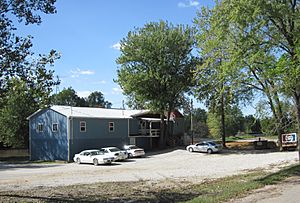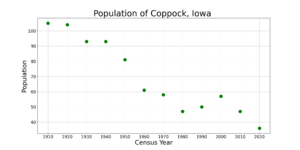Coppock, Iowa facts for kids
Quick facts for kids
Coppock, Iowa
|
|
|---|---|

Eagle's Nest in Coppock
|
|

Location of Coppock, Iowa
|
|
| Country | |
| State | |
| Counties | Henry, Washington, Jefferson |
| Area | |
| • Total | 0.24 sq mi (0.62 km2) |
| • Land | 0.23 sq mi (0.60 km2) |
| • Water | 0.01 sq mi (0.02 km2) |
| Elevation | 715 ft (218 m) |
| Population
(2020)
|
|
| • Total | 36 |
| • Density | 155.84/sq mi (60.24/km2) |
| Time zone | UTC-6 (Central (CST)) |
| • Summer (DST) | UTC-5 (CDT) |
| ZIP code |
52654
|
| Area code(s) | 319 |
| FIPS code | 19-16140 |
| GNIS feature ID | 2393632 |
Coppock is a very small city in Iowa, a state in the United States. It's special because it's located in three different counties at once: Henry, Jefferson, and Washington. According to the 2020 census, only 36 people live there.
The part of Coppock in Washington County is considered part of the Iowa City area. Today, there's only one business open to the public in Coppock, which is a tavern and a place for boats to land.
Contents
History of Coppock
Coppock started in 1859 when two men, John Coppock and Thomas Tucker, built a grist mill and a saw mill on the Skunk River. A grist mill grinds grain into flour, and a saw mill cuts wood. John's son, Thomas Coppock, later opened a general store nearby. These businesses became a popular meeting spot for people in the area. By 1877, the grist mill was a large four-story building. It also included 360 acres of land, four houses, and a ferry to cross the river.
In 1882, Coppock's mill became the site of a small "battle" between two railroad companies. The Iowa Central Railway and the Burlington and Western Railway both wanted to build bridges across the Skunk River in the same spot. Eventually, the Burlington and Western railroad was made wider and taken over by the Chicago, Burlington and Quincy Railroad. The Iowa Central railroad was later taken over by the Minneapolis and St. Louis Railway.
Railroads Bring Growth
When the railroads arrived, Coppock grew a lot. The town was officially planned out in 1882 with four city blocks. Both railroads ran side-by-side south of the town. Each had its own train station (called a depot), a special track for trains to wait (a siding), a place for animals (a stock yard), and a water tank. The Burlington and Western also had a place to load coal onto trains.
In 1883, John Coppock Jr. bought the mill and its dam. By 1887, the mill was a huge six-story building. During winter, collecting ice became a big business. The Burlington and Western Railway even built a special track just for loading ice. They also advertised that Coppock had lots of gravel and crushed stone available.
Fun Parks and Tourism
By the late 1800s, two parks, Trite's Park and Brown's Park, became popular tourist spots. They offered swimming, boating, picnic areas, and places for groups to gather. There was even a small steamboat for trips on the river and a "toboggan slide" that went right into the water! All these fun activities were close to the train stations.
People could even charter a passenger car from Burlington on the Burlington and Western Railway. The train car would be left on a siding at Coppock for the day, and then picked up by the evening train to return to Burlington. Sadly, a big flood in 1903 destroyed both of these parks.
Coppock Becomes a City
Coppock officially became a city on February 24, 1902. By then, the town had a hotel, several general stores, and a blacksmith shop, in addition to the mill. The population was highest between 1910 and 1920, with over 100 people. However, it slowly dropped to 93 by 1930. The old Coppock mill was moved to Wayland in 1917.
The Burlington Route (part of the Chicago, Burlington and Quincy Railway) stopped its train service through Coppock in 1934 and removed its tracks a year later. In 1935, the road from Wayland to Coppock was covered with gravel, making it usable all year. The Minneapolis and St. Louis Railway continued to operate trains through Coppock until 1971.
Geography
Coppock is located right on the Skunk River. It's just above where the Skunk River meets another stream called Crooked Creek.
The city covers a total area of about 0.24 square miles (0.62 square kilometers). Most of this area, about 0.23 square miles (0.60 square kilometers), is land. A small part, about 0.01 square miles (0.02 square kilometers), is water.
Population Information
| Historical populations | ||
|---|---|---|
| Year | Pop. | ±% |
| 1910 | 105 | — |
| 1920 | 104 | −1.0% |
| 1930 | 93 | −10.6% |
| 1940 | 93 | +0.0% |
| 1950 | 81 | −12.9% |
| 1960 | 61 | −24.7% |
| 1970 | 58 | −4.9% |
| 1980 | 47 | −19.0% |
| 1990 | 50 | +6.4% |
| 2000 | 57 | +14.0% |
| 2010 | 47 | −17.5% |
| 2020 | 36 | −23.4% |
| Source: and Iowa Data Center Source: |
||
2020 Census Details
In 2020, the census counted 36 people living in Coppock. There were 10 households and 9 families. This means there were about 156 people per square mile. Most residents (91.7%) were White.
- Out of the 10 households:
- 60% had children under 18 living with them.
- 60% were married couples.
- 20% had a female head of household without a partner.
- 20% had a male head of household without a partner.
The average age in Coppock was 33 years old.
- About 27.8% of residents were under 20 years old.
- About 33.3% were between 25 and 44 years old.
- About 16.7% were 65 years or older.
There were more males (61.1%) than females (38.9%) in the city.
See also
 In Spanish: Coppock (Iowa) para niños
In Spanish: Coppock (Iowa) para niños


